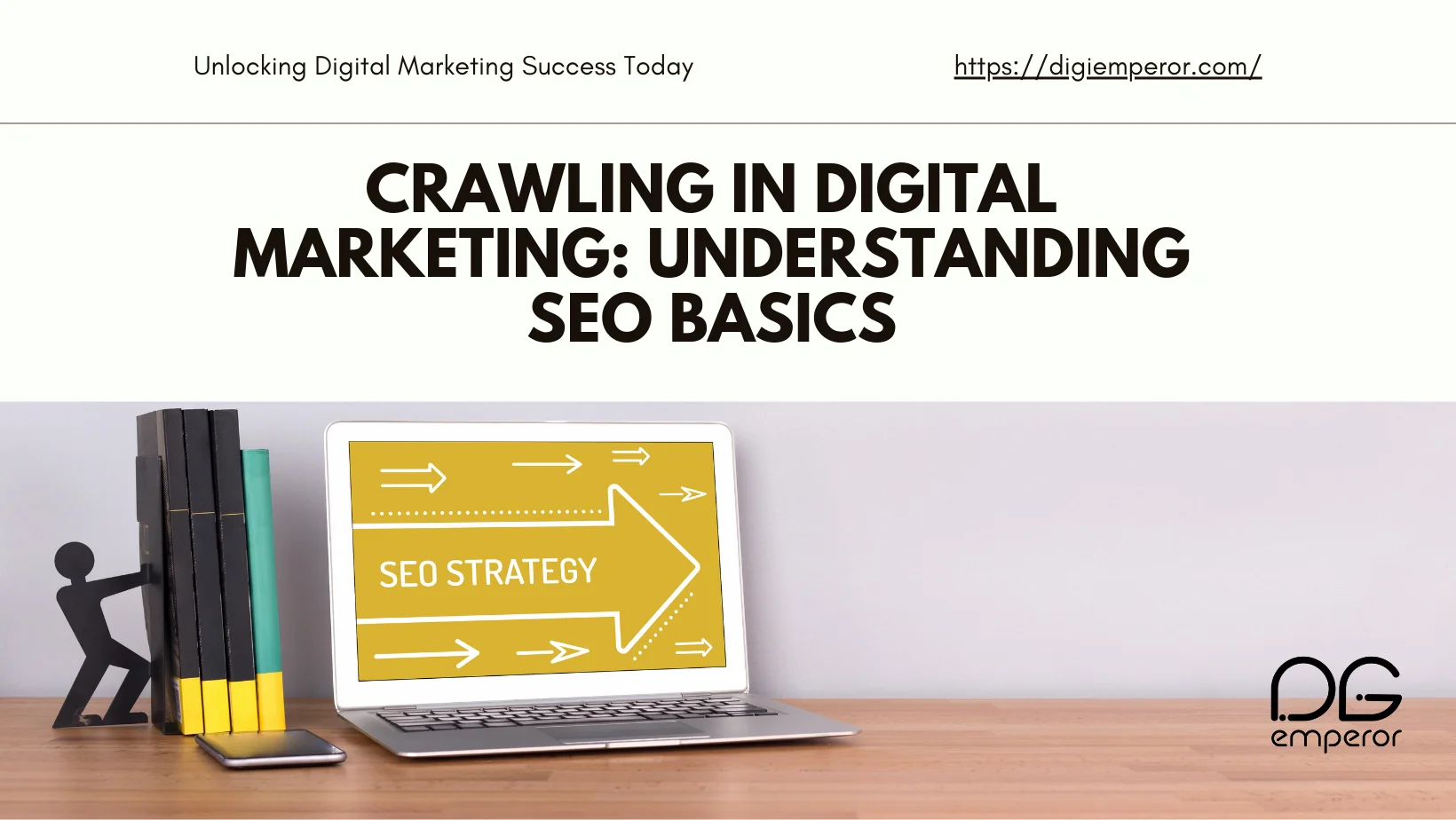Introduction to SEO in Digital Marketing

In modern digital advertising, search engine optimization (SEO) is an essential aspect of marketing strategy training. SEO involves a series of strategies aimed at increasing your website’s visibility on search engines like Google. By enhancing your website’s ranking, SEO helps drive more organic (non-paid) traffic to your site, leading to increased conversions and sales by Digi Emperor.
The Importance of SEO for Businesses in Digital Marketing
For businesses, SEO is crucial. It not only improves visibility but also establishes credibility and trust among potential customers. A well-optimized website makes it easier for search engines to index your content, making it more likely to appear in relevant search results.
Benefits of SEO
Increased Traffic: Higher ranking on search engine results pages (SERPs) leads to more clicks and traffic.
Better User Experience: SEO involves optimizing site speed, mobile-friendliness, and user-friendly navigation, improving overall user experience.
Higher Conversion Rates: Optimized websites provide relevant content and easy navigation, leading to higher conversion rates.
Brand Credibility: Appearing on the first page of search results builds credibility and trust among users.
Understanding How Search Engines Work
Search engines like Google use complex algorithms to rank websites. Understanding these algorithms can help you optimize your website effectively.
Crawling
Crawling is the process by which search engines scan the web for content. Search engine bots (also known as spiders or crawlers) visit web pages and follow links to discover new pages. This process helps search engines understand the content and structure of websites.
Indexing
Once a page is crawled, search engines index it. Indexing involves storing and organizing the content found during crawling. Indexed pages are then eligible to appear in search results.
Ranking
Ranking determines the order in which indexed pages appear in search results. Search engines use various factors to rank pages, including keyword relevance, page quality, and user engagement metrics.
Key Components of SEO
To optimize your website for search engines, you need to focus on several key components of SEO.
On-Page SEO
On-page SEO involves optimizing individual web pages to rank higher and earn more relevant traffic. Key elements include:
Keywords: Research and use relevant keywords naturally within your content.
Meta Tags: Optimize meta titles and descriptions to accurately reflect page content.
Content Quality: Provide high-quality, informative, and engaging content.
URL Structure: Use clean and descriptive URLs.
Internal Linking: Link to other relevant pages within your website.
Off-Page SEO
Off-page SEO refers to activities outside your website that influence your search engine rankings. This includes:
Backlinks: Acquire high-quality backlinks from reputable websites.
Social Signals: Engage with audiences on social media platforms.
Guest Blogging: Write guest posts for other blogs in your industry.
Influencer Marketing: Collaborate with influencers to reach a wider audience.
Technical SEO
Technical SEO involves optimizing your website’s infrastructure to help search engines crawl and index your site more effectively. Key aspects include:
Site Speed: Ensure your website loads quickly.
Mobile Optimization: Make your website mobile-friendly.
XML Sitemaps: Create and submit XML sitemaps to search engines.
Robots.txt: Use robots.txt to control search engine crawling.
Structured Data: Implement structured data to help search engines understand your content.
Keyword Research and Optimization

Keyword research is a fundamental aspect of SEO. It involves identifying the terms and phrases your target audience uses to search for products or services like yours. Effective keyword research can significantly impact your SEO success.
Steps in Keyword Research
Brainstorming: List potential keywords related to your business.
Competitor Analysis: Analyze the keywords your competitors are targeting.
Keyword Tools: Use tools like Google Keyword Planner, SEMrush, and Ahrefs to find relevant keywords.
Long-Tail Keywords: Focus on long-tail keywords, which are less competitive and more specific.
User Intent: Understand the intent behind the keywords to provide relevant content.
Content Creation and Optimization
Content is king in SEO. Creating high-quality, relevant, and engaging content is essential for attracting and retaining visitors. Optimized content improves your chances of ranking higher on search engine results pages.
Tips for Creating SEO-Friendly Content
Keyword Integration: Use keywords naturally within your content without overstuffing.
Engaging Titles: Craft compelling titles that include your main keyword.
High-Quality Content: Provide valuable information that addresses your audience’s needs.
Multimedia Elements: Use images, videos, and infographics to enhance content.
Content Updates: Regularly update your content to keep it relevant.
Link-building strategies
Link building is a critical part of off-page SEO. It involves acquiring hyperlinks from other websites to your own. High-quality backlinks can boost your website’s authority and improve its ranking on search engines.
Effective link-building techniques
Guest Posting: Write and publish articles on reputable blogs.
Broken Link Building: Find broken links on other websites and offer your content as a replacement.
Skyscraper Technique: Create outstanding content and reach out to sites linking to similar content.
Influencer Outreach: Collaborate with influencers to get your content shared.
Measuring and Analyzing SEO Performance
To ensure your SEO efforts are effective, you need to measure and analyze your performance regularly. This helps you understand what’s working and where you need to make improvements.
Key Metrics to Track
Organic Traffic: Monitor the number of visitors coming from search engines.
Bounce Rate: Track the percentage of visitors who leave your site after viewing only one page.
Conversion Rate: Measure the percentage of visitors who complete a desired action.
Keyword Rankings: Track your rankings for targeted keywords.
Backlinks: Monitor the number and quality of backlinks to your site.
Tools for SEO Analysis
Several tools can help you analyze and improve your SEO performance. These tools provide valuable insights into your website’s performance and identify areas for improvement.
Popular SEO Tools
Google Analytics: Provides detailed insights into website traffic and user behavior.
Google Search Console: Helps monitor and maintain your site’s presence in Google search results.
SEMrush: Offers comprehensive SEO analysis and competitor research.
Ahrefs: Provides in-depth backlink analysis and keyword research.
Moz: Offers tools for keyword research, link building, and site audits.
Advanced SEO Strategies
To take your SEO to the next level, consider implementing advanced strategies that go beyond the basics. These techniques can provide a competitive edge and drive even more traffic to your website.
Voice Search Optimization
With the rise of voice-activated assistants like Siri, Alexa, and Google Assistant, optimizing for voice search is becoming increasingly important. Voice search queries are typically longer and more conversational than text searches, so focus on long-tail keywords and natural language.
Mobile-First Indexing
Google now primarily uses the mobile version of a site for indexing and ranking. Ensure your website is fully optimized for mobile devices with responsive design, fast loading times, and easy navigation.
Video SEO
Video content is becoming a dominant force in digital marketing. Optimize your videos for search engines by using relevant keywords in titles, descriptions, and tags. Additionally, provide transcripts and captions to enhance accessibility and searchability.
Local SEO
For businesses that rely on local customers, local SEO is essential. Optimize your Google My Business listing, gather positive reviews, and ensure your name, address, and phone number (NAP) are consistent across all online platforms.
Common SEO Mistakes to Avoid
Even with the best intentions, it’s easy to make mistakes that can hinder your SEO efforts. Avoid these common pitfalls to ensure your strategy remains effective.
Keyword Stuffing
Overusing keywords in your content can lead to keyword stuffing, which is penalized by search engines. Focus on natural and relevant keyword integration instead.
Ignoring Mobile Users
With the majority of searches now conducted on mobile devices, ignoring mobile optimization can significantly hurt your rankings. Ensure your site is mobile-friendly and provides a seamless user experience on all devices.
Duplicate Content
Having duplicate content on your website can confuse search engines and dilute your rankings. Ensure all content is unique and valuable to your audience.
Neglecting Analytics
Failing to monitor and analyze your SEO manager’s performance means you won’t know what’s working and what needs improvement. Regularly review key metrics and adjust your strategy accordingly.
Future Trends in SEO
SEO is constantly evolving, and staying ahead of trends can give you a competitive advantage. Here are some future trends to watch out for:
Artificial Intelligence
AI is playing an increasingly significant role in SEO, particularly in the form of machine learning algorithms like Google’s RankBrain. These algorithms help search engines understand user intent and deliver more relevant search results.
User Experience
As search engines become more sophisticated, user experience (UX) is becoming a critical ranking factor. Focus on providing a seamless, intuitive, and enjoyable experience for your visitors.
Zero-Click Searches
More searches are ending without a click, as Google provides direct answers through featured snippets and knowledge panels. Aim to have your content featured in these positions by answering common questions clearly and concisely.
Local SEO: Enhancing Your Local Presence

Local SEO is essential for businesses that serve specific geographic areas. By optimizing your local presence, you can attract more customers from your immediate vicinity.
Optimizing Google My Business
Google My Business (GMB) is a free tool that allows businesses to manage their online presence across Google, including searches and Maps. Ensure your GMB listing is complete with accurate information, high-quality photos, and positive customer reviews.
Local Citations and Listings
Consistent NAP information across all online directories and platforms is crucial. Ensure your business name, address, and phone number are accurately listed on local directories, social media, and review sites.
Gathering Positive Reviews
Encourage satisfied customers to leave positive reviews on Google, Yelp, and other review platforms. Responding to reviews, both positive and negative, shows that you value customer feedback and are committed to improving your service.
SEO and Content Marketing Integration
Integrating SEO with your content marketing career can amplify your digital marketing techniques and efforts. By creating valuable content that resonates with your audience, you can drive more organic traffic and build lasting relationships with customers.
Creating Evergreen Content
Evergreen content remains relevant and valuable over time. Focus on creating high-quality articles, guides, and resources that address common questions and provide lasting value to your audience.
Content Promotion
Promoting your content through social media, email marketing, and influencer collaborations can extend its reach and drive more traffic to your website. Utilize these channels to share your content and engage with your audience.
SEO Best Practices
Adhering to SEO best practices can help you maintain a solid foundation and avoid potential pitfalls. These practices are tried-and-true methods that have consistently proven effective in improving search engine rankings and driving traffic.
Regularly updating Content
Search engines favor websites that regularly update their content. Ensure that your website’s information is current and relevant, and refresh old posts with new insights and data.
Optimize Images
Images can significantly impact your site’s loading speed and user experience. Optimize images by reducing their file size without compromising quality, and use descriptive file names and alt text for better SEO.
Use HTTPS
Security is a top priority for search engines and users alike. Implement HTTPS to ensure your website is secure, which can also improve your search engine rankings.
Improve Site Navigation
A well-structured website with clear navigation helps both users and search engines. Use a logical hierarchy for your site’s pages and include a sitemap to make it easier for search engines to crawl your site.
Understanding User Intent
Understanding user intent is critical for effective SEO. By aligning your content with what users are searching for, you can provide more relevant information and improve your chances of ranking higher.
Types of User Intent
Informational: Users are looking for information or answers to questions and digital marketing trends.
Navigational: Users are trying to find a specific website or page.
Transactional: Users are ready to make a purchase or complete a transaction.
Commercial Investigation: Users are researching products or services before making a decision.
Enhancing User Experience (UX)
A positive user experience is essential for retaining visitors and improving SEO. Focus on creating a seamless, enjoyable experience for users on your website.
Tips for Enhancing UX
Responsive Design: Ensure your website is fully functional on all devices.
Fast Loading Times: Optimize your site’s speed to reduce loading times.
Clear Calls-to-Action: Use clear and compelling calls-to-action to guide users.
Easy Navigation: Create an intuitive and easy-to-use navigation structure.
Engaging Content: Provide valuable, engaging, and easy-to-read content.
Leveraging Social Media for SEO
Social media can play a significant role in your SEO strategy. By leveraging social media platforms, you can increase your content’s visibility and drive more traffic to your website.
Tips for Using Social Media
Share Content: Regularly share your content on social media to reach a broader audience.
Engage with Users: Respond to comments and messages to build relationships with your audience.
Use Hashtags: Utilize relevant hashtags to increase the reach of your posts.
Collaborate with Influencers: Partner with influencers to amplify your content’s reach.
Monitor Performance: Use social media analytics tools to track the performance of your posts and adjust your strategy accordingly.
SEO for E-commerce Websites

E-commerce websites have unique SEO needs. By focusing on specific strategies tailored to e-commerce, you can improve your online store’s visibility and drive more sales.
E-commerce SEO Strategies
Optimize Product Pages: Use relevant keywords in product titles, descriptions, and meta tags.
Improve Site Speed: Ensure your online store loads quickly to enhance user experience.
Use High-Quality Images: Optimize images for faster loading times and better SEO.
Create Detailed Product Descriptions: Provide detailed and informative product descriptions to help users make informed decisions.
Implement Structured Data: Use structured data to help search engines understand your product information better.
The Role of Analytics in SEO
Analytics is a critical component of SEO. By analyzing data, you can gain insights into your website’s performance and identify areas for improvement.
Important Analytics Metrics
Organic Traffic: Monitor the number of visitors coming from search engines.
Bounce Rate: Track the percentage of visitors who leave your site after viewing only one page.
Conversion Rate: Measure the percentage of visitors who complete a desired action.
Keyword Rankings: Track your rankings for targeted keywords.
Backlinks: Monitor the number and quality of backlinks to your site.
Mastering SEO is essential for digital marketing success. By understanding the basics of SEO and implementing effective strategies, you can improve your website’s visibility, drive more organic traffic, and increase conversions. Stay updated with the latest SEO trends and continuously optimize your website to maintain a competitive edge in the digital landscape.
In summary, understanding the intricacies of SEO can significantly enhance your digital marketing efforts. By focusing on on-page, off-page, and technical SEO, conducting thorough keyword research, creating high-quality content, and building valuable backlinks, you can achieve higher search engine rankings and drive more traffic to your website. Regularly measuring and analyzing your SEO performance with the help of various tools will ensure that your strategies are effective and up-to-date, leading to sustained success in the ever-evolving digital world.
For more tips from Digi Emperor and SEO, read our next blog about Social Media. Start making your office better today!
FAQ




